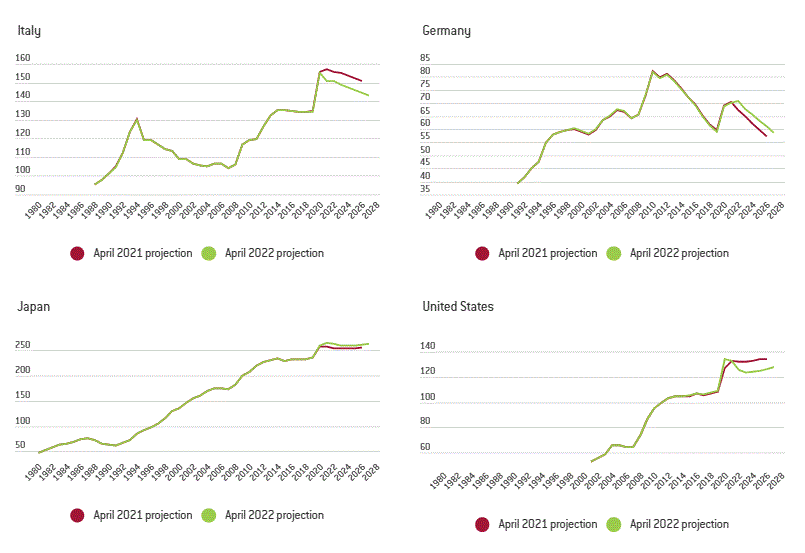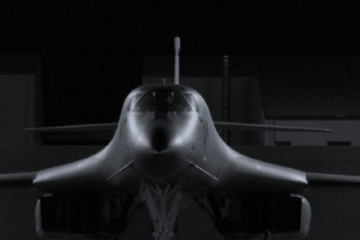Last Updated on 08/08/2022 by AIR OPERATIONS
Lots to digest over the past 4 weeks. Lots of signals and lots of noises, and very different directions that may move market and geopolitics away from linear dynamics into the more unpredictable realm of “non-linear chaos”. Relatively predictable (and academic) patterns observed in previous crisis can now hinge on the complex and events that may seemingly be disconnected. We focus on the economy in this update – we view the next 6 months as particularly pivotal.
Economics
Bruegel has an interesting (and long) piece: The implications for public debt of high inflation and monetary tightening
Decomposing the changes in the 2022 and 2021 IMF public debt-to-GDP ratio forecasts for 2026 suggests that the impact of monetary tightening and worsened economic outlook is relatively small, while inflation reduces debt ratios very substantially. This explains why both the IMF and the European Commission lowered the public debt-to-GDP ratio forecasts for most EU and advanced countries.
Simply said – there is no guarantee that inflation will be rapidly tamed by an increase in interest rates and that it may take closer to two years to return to near 2pct inflation curve in the West. Bad news.
Read the complete piece here: The implications for public debt of high inflation and monetary tightening
We are doubling down on the macro economic outlook – a reflection of what torments us lately. This excellent piece from Nouriel Roubini is asking very important questions:
The second question is whether the increase in inflation was driven more by excessive aggregate demand (loose monetary, credit, and fiscal policies) or by stagflationary negative aggregate supply shocks (including the initial COVID-19 lockdowns, supply-chain bottlenecks, a reduced US labor supply, the impact of Russia’s war in Ukraine on commodity prices, and China’s “zero-COVID” policy).
Will monetary-policy tightening by the US Federal Reserve and other major central banks bring a hard or soft landing? Until recently, most central banks and most of Wall Street occupied “Team Soft Landing.” But the consensus has rapidly shifted, with even Fed Chair Jerome Powell recognizing that a recession is possible, and that a soft landing will be “very challenging.”
We expect a soft landing that will feel like a hard one due to the length of time that this recession might occupy. Our chief concern has to do with the interest rate increase discipline from the Federal reserve that may be pitted against political pressures in a heated election year. If the economy softens, stopping or even reversing interest rates could have serious consequences on a rampant inflation. Push interest rates too high and we may end up getting a taste of 1970s/80sm style recession. Roubini correctly predicts that” once a hard landing becomes imminent, because they will be worried about the damage of a recession and a debt trap, owing to an excessive build-up of private and public liabilities”
We unfortunately wholeheartedly agree with Professor Roubini when he makes the case for a severe debt crisis: ” the next recession will be marked by a severe stagflationary debt crisis. As a share of global GDP, private and public debt levels are much higher today than in the past, having risen from 200% in 1999 to 350% today (with a particularly sharp increase since the start of the pandemic). Under these conditions, rapid normalization of monetary policy and rising interest rates will drive highly leveraged zombie households, companies, financial institutions, and governments into bankruptcy and default.”
An excellent read: A Stagflationary Debt Crisis Looms
Aircraft OEMs
‘Tis the season of: OEM 20 year market outlooks. Boeing published theirs during the Farnborough airshow and Airbus released theirs right before the show and good news: the world will continue to need an excessive amount of shiny things with wings; Pangloss was right again: “all is for the best in this best of all possible worlds”.
Except for the fact that all OEMs’ forecasts are “nominal” case, which is fine in a linear world with a finite life of about 12 months. We are not dismissing these projections, ours are precisely based on a rather similar outlook but it is important to assume that crisis “is the normal state of affairs” as Pr.Niall Ferguson often says. Something not mentioned in either forecasts: the end of the multipolar world and the consequential end of free ranging for the duopoly.
Here are both OEMs respective documents:
Boeing CMO and Airbus GMF
Our GDP forecast supports 30,850 aircraft to 2035 (7 years short of the OEMs)
Supply Chain
Another interesting piece from Alex Krutz in Aviation Week on how Private Equity can support the next aviation innovation cycle.
Avweek: How Private Equity Could Boost Aerospace For Next Super-Cycle
Geopolitics
China and Taiwan. Much ado about something but we are of the opinion that China will not seek imminent confrontation with Taiwan and the US. While tensions will grow and remain high, we also believe that China is in no way capable of winning an engagement against the United States and allies at this juncture, and are smart enough to know it. They lack operational experience and integrated conops.
Western media gesticulations are based on macabre anticipation that something “should go wrong” to feed the news beast mostly, but Former CIA Director Gen. David Petraeus wisely commented this WE that: “President Xi is seeking to bring this to an end, China’s eastern command announced that they completed their live fire training. I see no prospect for conflict.”
The China Aerospace Studies Institute – Air University, has a very interesting but long webinar on Taiwan issues.
Commercial Aviation
Another video – this time of “E3”, the Embraer concept for a next generation turboprop being studied for over 6 years now.
We believe that a nextgen turboprop (TP) can be transformative and contribute to essential services, particularly in the EU and NA. With bureaucrats targeting commercial aviation as the worst thing since freedom of speech, the E3 has plenty to potentially offer in terms of reduced emissions and improved passenger comfort. US passengers have indeed rarely been exposed to decent comfort levels on regional TP aircraft, only recently have they been experiencing fairly decent interiors with the ATR72-600 operated by Silver Airways. In our opinion, the Porter Airlines or Alaska Airlines interiors for the Q400 are substandard.
Defense
While the Air Force may have chosen to order more KC-46 (unofficially), it is the future tanker that is of interested to us.
A blended wing design is indeed “optimized” for longer range missions and fuel offload capabilities. It also presents interesting cargo capabilities and loading due to wing configuration.
Read more: Air Force Wants Blended Wing-Body Aircraft Demonstrator Flying By 2026




